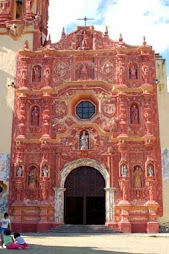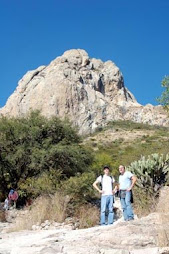
In their own names and warns the notable feature of this baroque dyed indigenous: Santiago de Jalpan, Our Lady of Light Tancoyotl, San Miguel Conca, Santa Maria del Agua de Landa and San Francisco del Valle de TILAC.
This beautiful, long barrier region, was a kind of natural shelter for the humans who lived here: Lakers, jonaces, guachichiles, all known under the generic name of Chichimecas. And in some ways, this imposing geography imposed its conditions on the story Colonial. The five Franciscan missions herein are unique both for its history and its architectural creation, which is unusual baroque as the consummation of miscegenation, a project built by the hands and imagination freely Indians. A true encounter. The missions are also a crystallization of a great humanist aspiration led by Fray Junipero Serra, the missionary of Majorcan origin who tried to be as radical as his spiritual father St. Francis of Assisi, and otherwise delayed, and let us say, desperate Advanced military led by Jose de Escandon.
Consider a fact that hurt the pride we assume Spanish, until 1740 the Viceroyalty had failed to "pacify" the cross and the sword to the people of this region. A nation of nations conquered and placed under 200 years ago by the power of the Spanish crown, and yet a small area close to the viceregal capital still remained indomitable. "What a shame!" Have some powerful thought, so Escandón undertaken in 1742, the siege on all rebel groups in the Sierra Gorda, which is why the rage that begins in 1748 with the latest offensive, the Battle of ominous Crescent, where the brutal epilogue captain exterminates almost all of these groups.
Amid these circumstances, reaching in 1750 the town of Jalpan, a group of Franciscan missionaries headed by Fray Junipero Serra. Its mission, to evangelize the Indians and completed the cross and the word tasks initiated by Escandón with weapons. But Fray Junipero worthy heir to the poor of Assisi, brought a very different mission, and in total opposition to the ideas promoted by the captain in the missions previously founded. Along with the notions of poverty and communion, in their own deep sense of San Francisco, Fray Junipero charged with utopian ideals of the best European humanism of the time. The climate of increasing violence and hostility and mistrust that had to be received by the various indigenous groups, Junípero opposed a strong missionary who was the support and understanding of social problems in their hunger for knowledge and language. As we noted anthropologist Diego Prieto, Junípero cooperatives founded and supported and strengthened their capacities for organization and production, led to the division of land and not only imposed the Castilian no time to evangelize, but did his work in theoretical language PAME. It is therefore a task of large scale and mission profound consequences in terms of human and whose results are visible today in the syncretism baroque harmonic and displaying this unique set of missions.
The baroque
At present, speaking of the Missions of Sierra Gorda, the first thing one thinks is in the five buildings, the five temples. There are, we should see them, you have to stop and contemplate a little more, the five beautiful missions. But as you noticed are the result of a rich and complex historical process of mutual evangelization, as something else. What we see today in every one of them, each altarpiece, is the product of that deep encounter between two groups of human nature is radically different. The conception of the world, religion, the notion of faith, the deities, animals and the light, color and complexion of the bodies and faces, food, sex, everything was so different between the friars who brought to Europe and the Indians who were in their land, but had been confined, robbed and subjugation. Something yet joined one of those strange moments or rather marginal in the stories of conquering a civilization to another: respect, recognition of the difference. It was brewing a utopia, a small group of Europeans to recognize the other, until the root injured in their dignity by their European peers themselves.
Beauty
Thus, the missions that today we are amazed by its singularbelleza, but this is the manifestation plastic, architectural, of that encounter, then human solar irradiation, where the temple was the home of a whole people, the core a series of activities that started from here or there to lead. That was the mission at that time, not the building but the vision of things, the eyes reflected in the temple, the new order I guess looking with amazement and difficult tasks that might be farmland, mutual aid, of strong defense against injustice, evangelizing.
So perhaps this is so admirable architectural mix, this baroque unparalleled, facade-retable because each is just that, a vision, a mise en scene at the time of contact and communion, yes, but where it was also, and Exceptionally, the difference. PAME Conca is a word that means "me", but that the mission also carries the name of San Miguel, San Miguel Arcángel there is crowning the facade and one side of a rabbit that has no Christian symbols but PAME. There is the Virgen del Pilar and the Virgin of Guadalupe Mission in Jalpan, we all know has deep roots Mesoamerican, and a two-headed eagle mixing meanings. There is the rich ornamental plant and the profusion of ears in Tancoyotl; Catholic saints or Lan Landa has, along with sirens or faces unmistakable traces of natives. There is TILAC to the bottom of a valley reminiscent of Jose Maria Velasco, with their angels, their ears and their strange pitcher who finishes the entire composition, above San Francisco.
Fray Junipero Serra only lasted eight years on this project, but his utopian dream came to 1770, when various historical circumstances, such as the expulsion of the Jesuits, in part caused the abandonment of the missions. He, however, continued its mission of evangelization and the Franciscan ideal until the end of his life in Alta California. The Franciscan missions of Sierra Gorda, the "five sisters," as called Diego Prieto and architect Jaime Font, is a wonderful legacy of that struggle to make the dream possible. Since 2003, the five sisters are considered World Heritage. In the distance, Fray Junipero and Franciscan missionaries, and the Lakers, and the jonaces Chichimecas, who built the missions, and the project of life, seem increasingly large.
La Sierra Gorda
It was decreed as a Biosphere Reserve on May 19, 1997, after being recognized as one of the areas of importance to bird conservation by the International Council for Bird Preservation Mexican, and being the 13th. Mexican reserves enter through the "Man and the Biosphere of the United Nations Educational, Scientific and Cultural Organization, to its International Network of Biosphere Reserves.
It is located in the physiographic subprovinces huasteco called Carso, part of which is the great mountain known as Sierra Madre Oriental.
The region declared a Biosphere Reserve is located northeast of the state of Querétaro de Arteaga, encompassing the towns of Jalpan de Serra, Landa de Matamoros, Arroyo Seco, Pinal de Amoles (88% of the municipal territory) and Peñamiller (69.7% of its territory). Is monitored by Conanp.


